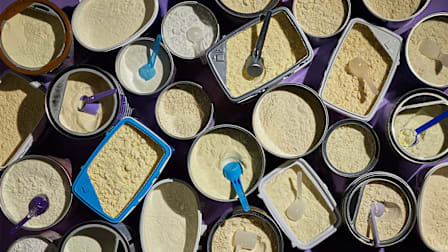Answering Your FAQs: High Levels of Lead in Protein Powders and Shakes
CR’s protein powder investigation inspired a lot of comment and debate. Here, we address the most frequently asked questions.

A recent Consumer Reports investigation found that many popular protein powders and shakes contain concerning levels of lead. The results sparked widespread interest among readers, many of whom rely on these products daily, as well as fervent online debate about the health risks of lead exposure, how the levels of contamination found in protein supplements compare with those in other foods, and CR’s testing methodology, among other subjects.
Here are answers to some of the most frequently asked questions, including how the benchmarks used by CR were derived, and guidance on what consumers should do next.
- Why Is CR's Level of Concern for Lead So Low?
- Isn’t Lead in Basically Everything You Eat?
- Why Do Some Protein Powder Makers Say Their Tests Show Less Lead?
- Did CR Account for the Differences in Serving Sizes? What About Flavor?
- What Should You Do if You’ve Been Drinking One of These Products for Years?
- Should You Get a Blood Lead Test?
- What Should You Do if You Use a Product CR Didn’t Test?
- Why Isn’t the FDA Doing Something About Lead in Protein Powder?
- What Makes Consumer Reports a Trusted, Credible Source on Protein Powders?
Why Is CR's Level of Concern for Lead So Low?
One way we displayed our test results is as a percentage of CR’s “level of concern” for lead, which is based on the California Prop 65 maximum allowable dose level (MADL) of 0.5 micrograms per day for lead.
CR uses this benchmark because it has a wide safety margin built in and our food safety experts believe it is the most protective lead standard available. “There is no safe amount of lead, and we think your exposure to it in the food and water supply should be as low as possible,” says Sana Mujahid, PhD, who oversees food safety research and testing at CR.
This line of thinking is echoed by public health authorities around the world: Both the Food and Drug Administration and the World Health Organization have repeatedly stated that there is no known safe level of exposure to lead.
And, to be clear, we’re not making any legal statements here: We use Prop 65’s threshold of 0.5 micrograms per day, but a different risk assessment method, so no Prop 65 conclusions can be drawn from our results. For more specifics about CR’s risk assessment, see this methodology sheet (PDF).
Isn’t Lead in Basically Everything You Eat?
Not quite. It is true that a very wide variety of foods from chicken to kale can contain unavoidable trace amounts of lead because of contamination in the environments where crops are grown and livestock are raised. Protein supplements presumably get some of their lead from the same environmental sources. But the results of CR’s investigation suggest the manufacturing and concentration processes involved in creating powders and shakes may contribute to heightened contamination risks.
The most recently available data from the FDA’s food contamination monitoring program provides context: The agency tested thousands of samples of 307 foods (including one protein powder and one meal replacement drink) purchased in stores across the U.S. over the course of three years and found lead in only 15 percent of samples. The highest levels were found in certain baby foods (sweet potatoes and teething biscuits), sandwich cookies, white wine, and low-calorie ranch dressing. The average lead concentrations in vegetables, fruit, and dairy products ranged from not detectable to 12 parts per billion, not detectable to 9.7 ppb, and not detectable to 2.1 ppb, respectively, depending on the product.
For comparison, average lead concentrations in the protein supplements CR tested ranged from not detectable to 70.2 ppb, and about 40 percent of products tested had lead levels exceeding 14 ppb. (This methodology sheet breaks down our test results in further detail, with values for lead, arsenic, cadmium, and mercury reported in micrograms per serving and parts per billion for each product tested.)
Why Do Some Protein Powder Makers Say Their Tests Show Less Lead?
In the weeks since CR published its investigation, some of the companies whose products we analyzed said their own heavy metal tests showed lower levels of lead. It’s possible that different batches of the same product contain different levels of lead. That said, to ensure our results weren’t skewed by an outlier batch, CR tested multiple samples of each product from two to four distinct “lots” (groups of products manufactured at different times or in different locations).
Our findings are based on an average of these samples, all of which were independently sourced and anonymously purchased by CR. The tests were conducted in a laboratory certified to standards set by the International Organization for Standardization for conducting such heavy metal analysis, and the results were analyzed and checked by a team of CR scientists.
Additionally, we measured metals like lead using a more sensitive analytical technique called triple-quadrupole inductively coupled plasma mass spectrometry, which CR chemist Eric Boring, PhD, says “allows for more sensitive analysis of elements at trace levels and better interference removal compared with more commonly used methods.” In at least some cases where companies were claiming nondetectable levels of lead, their limits of detection were not as sensitive as ours.
Did CR Account for the Differences in Serving Sizes? What About Flavor?
In the chart published with CR’s original investigation, results are displayed on a per-serving basis (as opposed to per gram) because that’s the dose the average user is most likely to consume. CR’s testing methodology sheet, which is linked in the article, breaks down these results in further detail, with values for lead, arsenic, cadmium, and mercury reported in micrograms per serving and parts per billion for each product.
Some of the protein powders CR tested were “mass gainers,” which are designed for bulking and have hefty recommended serving sizes ranging from 190 to 360 grams. But serving size did not appear to be a determinative factor in our testing. Case in point: While the product with the highest levels of lead in CR’s tests had a large serving size (315 grams), Muscle Tech’s Mass Gainer powder had an even larger serving size (357 grams) and no detectable lead.
About half the products we tested were chocolate-flavored, and some readers wondered if some of the lead we found came from chocolate. Indeed, previous tests by CR and others have identified chocolate as a noteworthy source of heavy metal contamination. But our protein tests found no meaningful difference between the average detectable lead level of the vanilla-flavored products and the average detectable lead level of the chocolate-flavored products. The average concentration of lead in the chocolate- and vanilla-flavored products CR tested was 17.3 parts per billion and 15.4 ppb, respectively.
What Should You Do if You’ve Been Drinking One of These Products for Years?
For starters, don’t panic. Long-term use of these products doesn’t mean you’ve harmed yourself. None of the protein supplements CR tested had high enough lead levels to cause immediate health effects, and many are fine for occasional use. (See the chart in CR’s original investigation for specific per-product recommendations.)
That being said, given that there is no known safe level of lead, and that you are likely already exposed to unavoidable amounts of it through your food and drink, this might be a good moment to reevaluate your habits and overall risk tolerance. Since experts say the average American already consumes more protein than recommended, you might consider whether supplements are addressing a genuine deficiency or if they are just a convenient habit. If it’s the latter, it may make sense to ask whether these products are worth the added exposure.
Should You Get a Blood Lead Test?
A doctor familiar with your medical history and applicable risk factors can best assess whether lead testing is right for you. The most common screening method is a blood lead level test, which measures the concentration of lead circulating in the bloodstream. But it doesn’t provide a complete picture.
Only a small fraction of the body’s total lead burden travels in the blood. More than 90 percent of absorbed lead is stored in bones, so blood tests often underrepresent the amount of lead in people with repeated or high-level exposure, according to the Centers for Disease Control and Prevention. That means people with chronic exposure to lead can show normal blood lead levels despite carrying a substantial lead burden.
Lead accumulates in the bones over decades, and it can be released back into the bloodstream in times of bodily stress—such as during pregnancy, illness, or old age—creating potential health risks long after exposure. That’s one of the reasons CR’s food safety experts believe your exposure to it in the food and water supply should be as low as possible.
What Should You Do if You Use a Product CR Didn’t Test?
If you are going to use protein supplements, you can reduce your lead exposure by limiting the number of servings you have each week and seeking out products that have confirmable low levels of lead.
Avoid products with Prop 65 warnings on the label, and check to see if test results for a product are available online before making a purchase. Of the brands CR tested, however, only Momentous and Transparent Labs said they publish them on their websites, and two additional companies—KOS and Equip Foods—said they will provide results to customers upon request.
If test results are unavailable, consider opting for products that use dairy-based sources of protein rather than plant-based. Better yet, make your own shakes by swapping out the powders for high-protein foods like peanut butter or Greek yogurt. This is especially important for children and people who are pregnant or could become so.
Why Isn’t the FDA Doing Something About Lead in Protein Powder?
The FDA has limited authority and does not review, approve, or test dietary supplements of any kind—including protein powders—before they are sold. There is no federal limit specifying the amount of lead allowed in protein powders. And while the FDA requires that manufacturers keep their products free of harmful contaminants, it largely leaves it up to companies to decide what counts as harmful and to test their own products for compliance.
CR’s consumer advocates have long expressed concern about the lack of regulation around supplements, and following this investigation launched a petition calling on the FDA to take action on protein powders specifically once the government shutdown ends. “No one should have to worry that their protein shake could expose them to dangerous levels of lead,” says Brian Ronholm, CR’s director of food policy. “It’s time for the FDA to protect the public and hold industry accountable by setting strong limits on lead in protein powders and shakes.”
What Makes Consumer Reports a Trusted, Credible Source on Protein Powders?
Consumer Reports is an independent, nonprofit organization that has been evaluating food and product safety since its founding in 1936 and has a long history of testing for heavy metals in food and water and championing marketplace change. CR’s staff—which includes journalists, food and product safety experts, scientists, and consumer advocates—operates free of influence from outside organizations and companies. Unlike other media companies, CR accepts no advertising and answers to no shareholders. CR pays for every product it tests and conducts independent research and testing.




















